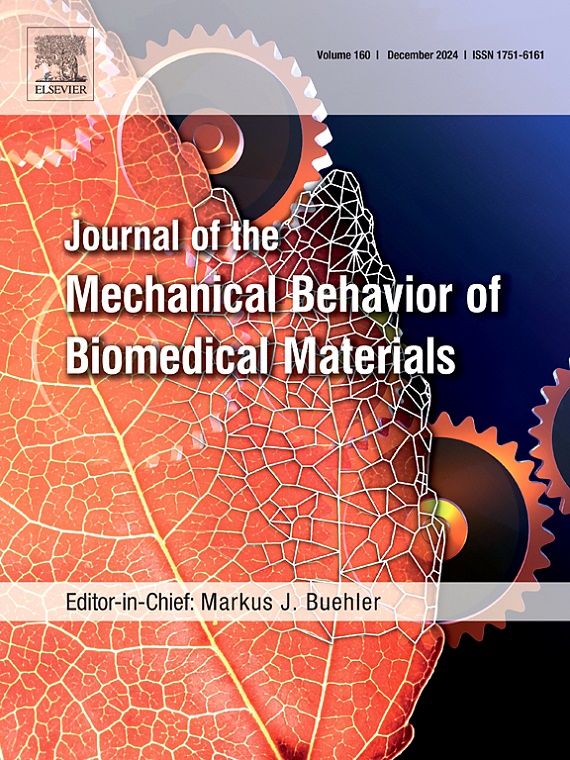Biomechanical study of an additively manufactured NiTi patient-specific device for the treatment of craniosynostosis
IF 3.5
2区 医学
Q2 ENGINEERING, BIOMEDICAL
Journal of the Mechanical Behavior of Biomedical Materials
Pub Date : 2025-06-16
DOI:10.1016/j.jmbbm.2025.107095
引用次数: 0
Abstract
Craniosynostosis, a pathological condition in which the fusion of cranial sutures prevents the normal development of the skull, may be treated by spring assisted surgery. The present work aims to employ additive manufacturing (AM) for the production of a novel NiTi spring distractor able to provide adequate and constant force during the treatment of nonsyndromic craniosynostosis. The use of AM allows to design patient-matched devices fitting the specific skull curvature of the new-borns, while the pseudoelastic behavior of NiTi can offer a constant force over a large deformation.
The proposed novel device consists of three pairs of unit cells, the shape of which was optimised using finite element analysis. Thereafter, patient-specific NiTi springs were produced by laser powder bed fusion and the functional behaviour of the material was assessed by differential scanning calorimetry (DSC) and tensile testing. The AMed material reached as high relative density as 99.6 %. The AMed spring prototype was tested at 37 °C, exhibiting a pseudoelastic response at 350 MPa up to 4 % in strain: this functional behavior depended on the austenitic phase, that was detected at body temperature by the DSC scan.
The proposed prototype paves the way for the design of a first AMed NiTi medical device for the treatment of unicoronal craniosynostosis, and could be further extended to other minimally invasive treatments requiring bone remodelling.
一种用于治疗颅缝闭锁的增材制造镍钛患者专用装置的生物力学研究
颅缝闭锁是一种颅缝融合阻碍颅骨正常发育的病理状态,可通过弹簧辅助手术治疗。目前的工作旨在采用增材制造(AM)来生产一种新型NiTi弹簧牵张器,该牵张器能够在治疗非综合征性颅缝闭闭期间提供足够和恒定的力。AM的使用允许设计适合新生儿特定头骨曲率的患者匹配装置,而NiTi的假弹性行为可以在大变形时提供恒定的力。提出的新型装置由三对单元胞组成,其形状使用有限元分析进行了优化。随后,通过激光粉末床熔合生产患者特异性NiTi弹簧,并通过差示扫描量热法(DSC)和拉伸测试评估材料的功能行为。该材料的相对密度高达99.6%。在37°C下测试了AMed弹簧原型,在350 MPa下显示出伪弹性响应,应变高达4%:这种功能行为取决于在体温下通过DSC扫描检测到的奥氏体相。提出的原型为设计首个用于治疗单冠状颅缝闭锁的AMed NiTi医疗设备铺平了道路,并可进一步扩展到需要骨重塑的其他微创治疗。
本文章由计算机程序翻译,如有差异,请以英文原文为准。
求助全文
约1分钟内获得全文
求助全文
来源期刊

Journal of the Mechanical Behavior of Biomedical Materials
工程技术-材料科学:生物材料
CiteScore
7.20
自引率
7.70%
发文量
505
审稿时长
46 days
期刊介绍:
The Journal of the Mechanical Behavior of Biomedical Materials is concerned with the mechanical deformation, damage and failure under applied forces, of biological material (at the tissue, cellular and molecular levels) and of biomaterials, i.e. those materials which are designed to mimic or replace biological materials.
The primary focus of the journal is the synthesis of materials science, biology, and medical and dental science. Reports of fundamental scientific investigations are welcome, as are articles concerned with the practical application of materials in medical devices. Both experimental and theoretical work is of interest; theoretical papers will normally include comparison of predictions with experimental data, though we recognize that this may not always be appropriate. The journal also publishes technical notes concerned with emerging experimental or theoretical techniques, letters to the editor and, by invitation, review articles and papers describing existing techniques for the benefit of an interdisciplinary readership.
 求助内容:
求助内容: 应助结果提醒方式:
应助结果提醒方式:


